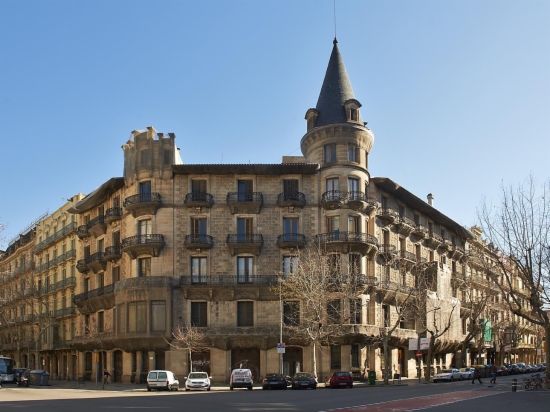Catalan Government plans to reduce its office space by 45%
The Catalan Finance Minister presented on Thursday a ‘Space Rationalisation and Optimisation Plan’ that foresees to partially leave Barcelona’s city centre and set up offices in cheaper areas. Nonetheless, the measure does not include citizen information and care centres such as schools and community health centres. Furthermore, the initiative also plans to reduce the global office space by using previously-empty floors and concentrating services without laying off staff. The objective is to pass from holding 377,000 square metres to fully occupying 207,000 square metres, a 45% reduction. By doing so, the Catalan Government expects to reduce rents by a 20% average, to cut off indirect costs by 50% and to decrease energy spending by 30%. Furthermore, it will sell the most appealing buildings.

Barcelona (ACN).- The Catalan Finance Minister, Andreu Mas-Colell, presented on Thursday a ‘Space Rationalisation and Optimisation Plan’ that foresees to partially leave Barcelona’s city centre and set up offices in cheaper areas. Nonetheless, the measure does not include citizen information and care centres such as schools and community health centres, emphasised Mas-Colell. The initiative plans to reduce the global office space by using previously empty space and concentrating services without laying off staff. The objective is to pass from holding 377,000 square metres to 207,000 square metres, a 45% reduction. Furthermore, the average space per employee (counting common and empty areas) will pass from 25 to 15 square metres. By doing so, the Catalan Government expects to reduce rents by an average of 20%, to cut off indirect costs by 50% and to decrease energy spending by 30%. Furthermore, it will sell the most appealing buildings, which will have been previously vacated. The Catalan Finance Ministry will elaborate a list of the most difficult buildings to sell, which will concentrate services. However, Mas-Colell underlined the difference between this plan and the previous building sales, since now the ultimate objective is not to make some immediate money but to rationalise spending in order to increase efficiency. In the 2011-2013 period, the Catalan Government saved €22.9 million per year by cancelling some rents and renegotiating other ones.
The Catalan Government will leave the offices that it currently owns and rents in Barcelona’s city centre. Furthermore it will renegotiate rents, sell some of its own buildings and concentrate offices in building located in cheaper areas of Greater Barcelona. Mas-Colell announced his personal commitment to reach agreements with staff representatives in order to relocate the staff, while also stating that these new offices would be near public transportation. Furthermore, he insisted the plan does not foresee laying off staff but concentrating services and reducing the global space used.
Citizens will not be directly affected
The Catalan Finance Minister emphasised that the plan only deals with offices, and not buildings where citizens go to receive care or make specific procedures. According to Mas-Colell, the buildings which offer direct services to citizens will remain open. Furthermore, he insisted that the plan should not affect the quality of pubic services. Besides, transferring the offices outside of Barcelona’s city centre has one main advantage: it will contribute to “boost” other urban areas.
Making a list of buildings to sell
The Catalan Government is currently making a list of the most appealing buildings, the ones that would be the easiest to sell, and which are mostly located in Barcelona’s city centre. The objective is to reduce spending and increase extra revenue. The activity and staff would be concentrated in other public buildings. An example of this is the main headquarters of the Catalan Finance Ministry, which occupies an Art-Nouveau building in Rambla Catalunya and Gran Via. This building has been gradually abandoned to concentrate services in a neighbouring spot, which is less attractive in the real state market.
Concentrating services in the most-difficult-to-sell buildings
In fact, the second part of the plan is to identify the buildings which would be the most difficult to sell. These would then concentrate the activities that the Catalan Government is currently undertaking in rented offices. It is the case of Catalonia’s Audiovisual Council (an independent authority that regulates audiovisual communication) and of the Agency for the University System’s Quality (AQU). They used to each rent a building of their own before transferring to a common office building owned by the Catalan Government in Vergós Street.
Increasing occupation
Regarding rented buildings that the Catalan Government cannot abandon for contract reasons, the Executive will try to renegotiate the contracts and to increase the building’s occupation to make them more profitable. In this vein, Mas-Colell explained that currently the average space available per staff member (including shared and empty areas) represents 25 square metres per person. The objective is to reduce this space to 15 square metres.
“Rationalising” is always needed
Mas-Colell affirmed that “even under regular conditions”, without the current financial crisis, the Catalan Government “has to undertake a process of rationalisation, which will always target efficiency and save money”. He also added that selling assets to just obtain liquidity “does not make sense”. He emphasised that “a broader plan” is needed to increase efficiency and reduce spending.